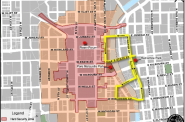Barrett Calls For $44 Million In Workforce And Housing Spending
Funds would come from $394 million federal ARPA grant.
Mayor Tom Barrett is rolling out his “Milwaukee Recovery and Resilience Plan” for the city’s $394 million federal American Rescue Plan Act grant.
In separate press conferences, he announced a $30.4 million proposal to fund a variety of housing development and stabilization efforts and $13.8 million for workforce development programs.
“What was paramount to me was to find those needs and those areas where we needed to get the dollars flowing right now,” said Barrett in a press conference Monday. The mayor said more funding proposals will be made this week and that a focus is being put on having an equitable impact. “Every portion of this plan was reviewed through a racial equity lens.”
The housing plan, unveiled Sunday, would allocate money to everything from new housing development to eviction prevention. Funds would expand capacity in existing efforts and back the creation of new programs. The largest single allocation, $15 million, would go towards infrastructure and new housing construction at the former Westlawn public housing complex near N. 64th St. and W. Silver Spring Dr.
“I view housing as one of the most pressing issues the city faces right now,” said Barrett.
The workforce plan, unveiled Monday morning, is centered on a partnership with job-training organization Employ Milwaukee.
“Without a doubt, workforce development and job readiness are two key challenges we face in the city of Milwaukee,” said the mayor. “We know that too many residents of Milwaukee are not connected to jobs that pay well or have opportunities for advancement.”
The largest workforce-related program is $6 million for Employ Milwaukee’s Job Training Project. The training will prioritize lead abatement certification training, something the city has long struggled to hire contractors to perform. “Lead abatement without a doubt is one key issues we face as a community,” said Barrett. The mayor said he hoped a federal infrastructure bill would fund lead lateral replacement and lead paint abatement.
The plan will be reviewed by the Common Council in the coming weeks. The only funding allocation approved to date is $3.8 million to the city’s Earn & Learn program targeted at creating educational, summer jobs for Milwaukee high school students.
Workforce Development
“Historic inequities in our communities have only been exacerbated during the pandemic,” said Brown in describing the need for workforce development in a tight labor market.
Employ Milwaukee is partnering with WRTP/BIG STEP on the ARPA workforce development effort. “Throughout 2020 at our training facility, we saw record numbers of people asking for training, whether it was to reskill or enter new job requirements,” said WRTP/BIG STEP CEO Lindsay Blumer. She said more than two-thirds of those requesting help were women or people of color.
Laura Bray, Milwaukee Area Technical College vice president and Employ Milwaukee board member, said the region is suffering from a “skills gap paradox.”
Bray said an individual would be able to get commercial driver’s license (CDL) training and then enter MATC to develop even more truck driving skills. A similar pipeline is being built for information technology using a bootcamp model. “We are trying to work as a system,” she said.
In addition to $6 million for the Job Training Project, $3 million would go towards a “Skillful Transitions Project” targeted at individuals ages 18 to 29.
The City’s Environmental Collaboration Office would oversee a $2.7 million allocation targeted at a Century City clean energy jobs program. As Urban Milwaukee reported in June, the office is seeking to develop a modular house factory with a private partner at Century City.
During the press conference, Barrett did not delineate where the remaining a $1.9 million would go. Barrett’s office did not respond to a request for comment on the issue by the time of publication.
Housing Development
Barrett made the housing announcement at the home of Juanita and Westley Jackson on N. 54th St.
“The Jacksons are a perfect example of the families we are trying to help,” said Barrett on Sunday. “They are on a fixed income, they have been in their home a long time, they are good property owners, they are good property taxpayers, yet they face some issues with their home.”
Barrett’s proposal would allocate an additional $3 million to the program.
Funds would also go towards a new program to review and hire contractors to make energy efficiency improvements to homes occupied by low-income families ($5 million), closing funding gaps in three “shovel ready” affordable housing developments, City Place Two, EIGHTEEN87 on Water and a Washington Park neighborhood scattered sites project ($2 million), the newly-created Milwaukee Right to Counsel eviction prevention program led by the Legal Aid Society of Milwaukee ($1.8 million), hiring more personnel at the Housing Authority of the City of Milwaukee to speed-up cleaning and repairs to vacant units ($1.2 million), expanding home buying and foreclosure counseling programs in partnership with the United Community Center, ACTS Housing and Housing Resources, Inc. ($1.2 million) and supporting the one-stop Rental Housing Resource Center that is operated by 10 partners and housed at Community Advocates, 728 N. James Lovell St. ($1.2 million).
In June, Alderman Robert Bauman introduced a more ambitious, $150 million proposal that calls for the renovation and sale or lease of the approximately 700 city-owned homes acquired in property tax foreclosure. Further discussion of his proposal was held pending the release of Barrett’s plan.
If you think stories like this are important, become a member of Urban Milwaukee and help support real, independent journalism. Plus you get some cool added benefits.
More about the American Rescue Plan Act
- Homes MKE Putting First-Time Buyers Into Rehabbed Homes - Nick Rommel - Nov 21st, 2024
- MKE County: As Deadline Looms, County Should Shift Stimulus Funding - Graham Kilmer - Dec 8th, 2023
- A Mix of Speed Hump and Crosswalk, New Street Feature All About Safety - Jeramey Jannene - Oct 30th, 2023
- Transportation: Construction Underway on Traffic Calming Projects - Jeramey Jannene - Oct 12th, 2022
- Eyes on Milwaukee: City Seeking Affordable Housing Developers Who Need Funding - Jeramey Jannene - Jul 25th, 2022
- Transportation: Milwaukee Seeks Partners On Project Lowering Speed Limits - Jeramey Jannene - Jul 1st, 2022
- City Hall: ARPA Funds Can’t Plug City Budget Hole - Jeramey Jannene - Jun 15th, 2022
- Plats and Parcels: City Seeks Firms To Transform Vacant Homes - Jeramey Jannene - May 1st, 2022
- Transportation: DPW Plans Surge of Traffic-Calming Bump Outs - Jeramey Jannene - Apr 26th, 2022
- City Hall: Federal Grant Could Help Stave Off 1,300 Layoffs - Jeramey Jannene - Apr 14th, 2022
Read more about American Rescue Plan Act here

























Regarding lead water pipes: I drank City of Milwaukee water that ran through lead pipes for the first 40 years of my life… Now I’m 67 years old and I’m healthier and happier than Tarzan…
If lead water pipes are a problem in Milwaukee, why haven’t there been large numbers of Milwaukee residents in the hospital over the past 150 years with lead poisoning?